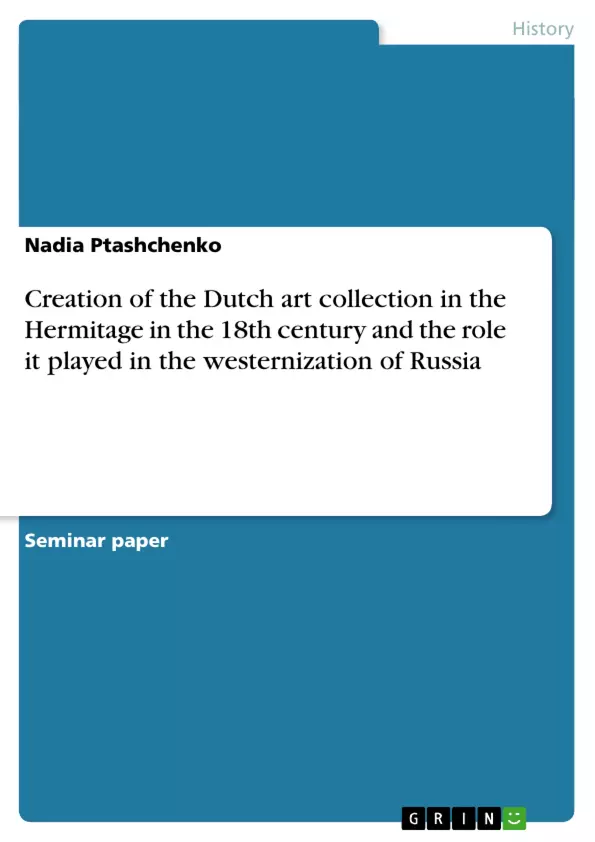This paper attempts to follow the cultural channels and actual steps taken by Peter the Great and his successors to cultivate Western European tastes in Russia and to direct the Russian Empire to a Western path of development. It investigates the historic role of St. Petersburg as Russia’s “window on Europe”, and features the great masterworks of Western European art (namely, Dutch) assembled and prized in the Hermitage by the Romanov dynasty, by Peter the Great and by his spiritual follower and enlightener - Catherine the Great, in particular.
Over the course of centuries, Russian tsars continuously borrowed ideas and concepts from their Western neighbors. St. Petersburg was to mark the way for Russia to become modern by creating an environment that could be maintained only by broader and deeper contact with the West. However, Peter Rietbergen in his essay on “Russia between West and East” stresses “the inherent duality in Russian culture, and in the national character, as half-Asian, half-European”. This issue is to be discussed and evaluated in the paper. A chronological overview of the main acquisitions of Dutch paintings to the Hermitage in the course of the XVIII century is included in the paper. It is hoped that the paper will add to the understanding of the described epoch of the Russian Empire and will expose the role it played in defining its path of historical development.
The thesis statement investigated in the paper is as follows: “Has the borrowing of cultural values from Western Europe contributed to the Europeanization of Russia in the XVIII century?” Under the term “cultural values” artefacts, objects of art, enlightening ideas and books, as well as progressive reforms, European fashion and lifestyle, etc are implied. One of the aims of the research is to demonstrate that art which has been broadly studied from divergent viewpoints of style, content, iconography, philosophy, and the social sciences, can also be approached as a function of economic and socio-political motives. A method of comparative analysis of the Westernizing cultural policies by Peter I and later, by Catherine II is used.
Inhaltsverzeichnis (Table of Contents)
- Introduction
- Chapter One
- Beginning of Westernization and reformation of Russia in the 18th century by Peter the Great. Saint Petersburg as a "window on the West"
- Chapter Two
- Catherine the Second, a spiritual successor of Peter the Great and the creation of the Dutch art collection in the Hermitage in the 18th century
- Conclusion
- Bibliography
Zielsetzung und Themenschwerpunkte (Objectives and Key Themes)
This paper investigates the process of Westernization in Russia during the 18th century, focusing on the cultural channels and actions taken by Peter the Great and his successors. It analyzes the role of St. Petersburg as a “window on Europe” and the significance of the Dutch art collection assembled at the Hermitage.
- Westernization of Russia under Peter the Great and Catherine the Great
- The role of St. Petersburg as a "window on the West"
- The influence of Dutch art on Russian culture
- The Hermitage collection and its contribution to Europeanization
- The cultural and socio-political motives behind the acquisition of Western art
Zusammenfassung der Kapitel (Chapter Summaries)
Chapter One discusses the beginning of Westernization in Russia during the reign of Peter the Great. It examines how the establishment of St. Petersburg as a “window on Europe” symbolized Russia's new direction and served as a bridge to Western culture. It highlights Peter's efforts to introduce Western ideas, technology, and arts into Russia, including his encouragement of travel abroad, the establishment of educational institutions, and the translation of Western books. Peter's personal fondness for Dutch art is also explored, laying the foundation for the future Dutch art collection at the Hermitage.
Schlüsselwörter (Keywords)
This paper explores the keywords Westernization, St. Petersburg, Dutch art, Hermitage collection, Europeanization, Peter the Great, Catherine the Great, cultural values, and socio-political motives.
- Quote paper
- M.A. Arts Nadia Ptashchenko (Author), 2008, Creation of the Dutch art collection in the Hermitage in the 18th century and the role it played in the westernization of Russia, Munich, GRIN Verlag, https://www.grin.com/document/133203



